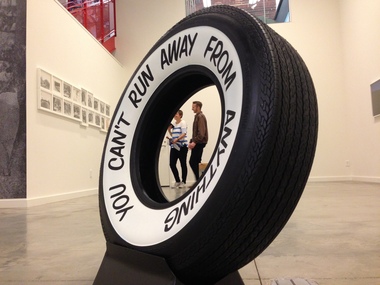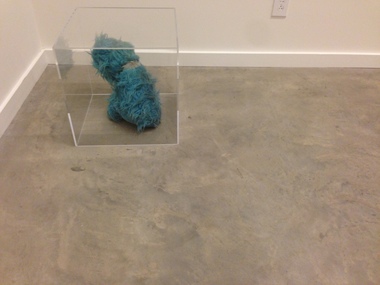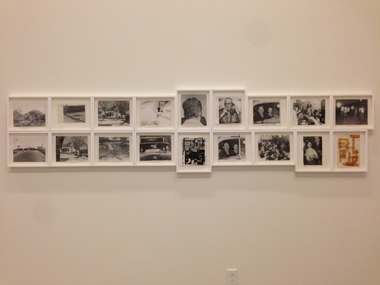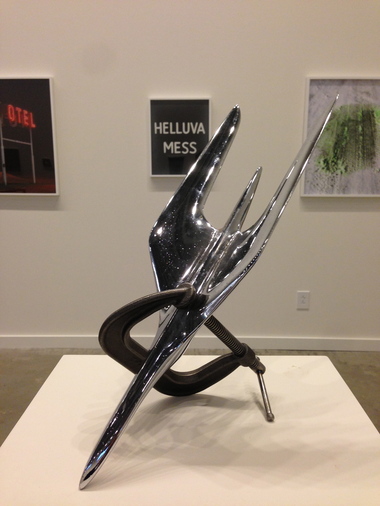Plain Dealer Reviews Redheaded Peckerwood
02/06/14
The Transformer Station and the Starkweather killing spree: When are multiple homicides a fitting subject for art? (Review)
Steve Litt - Plain Dealer
CLEVELAND, Ohio -- The Transformer Station's big spring exhibition, "Redheaded Peckerwood," is a difficult and uncomfortable experience. It could hardly be otherwise.

The hand-painted white-walled tire in "Redheaded Peckerwood" is part of the eclectic approach to the Starkweather killings of 1957-58 taken by artist Christian Patterson at the Transformer Station. Steven Litt, The Plain Dealer
In photographs, hand-painted signs, magazine clippings and actual pieces of evidence, the exhibition retraces the trail of mayhem left by 19-year-old Charlie Starkweather, who murdered 11 people in Nebraska and Wyoming during the winter of 1957-58, while accompanied by his 14-year-old runaway girlfriend, Caril Ann Fugate.
Starkweather was executed at Nebraska State Penitentiary in 1959; Fugate was sentenced to life in prison and paroled in 1976.
The question is why the gallery and New York artist Christian Patterson, who doggedly researched and documented the murder spree, have chosen to focus so much attention on it, and in what context.
On view through June 14, the exhibition frames the Starkweather killings as part of a long history of outlaw behavior in the United Staes involving young couples, guns and cars. It sets the tale within a tradition that includes the 1930s bank robberies of Bonnie Elizabeth Parker and Clyde Chestnut Barrow.
It also posits that Starkweather and Fugate were harbingers of an era of troubled teens in the 1950s and '60s that included the rebellious and misunderstood characters played by actor James Dean, reportedly a hero of Starkweather's.
There's a strong foundation for such a Hollywood-style perspective, because the Starkweather killings actually inspired movies including Terence Malick's 1973 "Badlands," Quentin Tarantino and Tony Scott's 1993 "True Romance," and Oliver Stone's 1994 "Natural Born Killers."

View full size
The stuffed toy in "Redheaded Peckerwood" was an actual piece of evidence from the Starkweather killings of 1957-58. Steven Litt, The Plain Dealer
Yet a wave of highly publicized mass killings committed across America by disturbed young men over the past 15 years also makes it possible to see Starkweather not as part of a romantic cultural tradition, but as a prophetic example of what happens when mental illness intersects with easy access to guns.
One of seven children born into a poor family, Starkweather had a speech impediment, severe myopia and bowed legs due to a birth defect, according to essays in a booklet that accompanies a book version of Patterson's project. Taunted at school with the epithet "Redheaded Peckerwood," the show's catchy title, Starkweather took revenge on the world.
His victims included Fugate's mother, stepfather and 2-year-old sister; a family friend; a couple who offered Starkweather and Fugate a ride; and a gas station attendant who refused to let Starkweather buy a stuffed animal on credit.
At a distance of 56 years, the killings may seem like relatively safe terrain for artistic exploration. Yet when viewed from the more contemporary perspective of Columbine or Virginia Tech or Chardon High School, "Peckerwood" feels oddly oblivious to other connotations the project might have.
In a sense, seeing the show is like viewing an exhibition about, say, Elliott Rodger, the misogynistic 22-year-old who killed six people in Isla Vista, Calif., on May 23. Or perhaps Adam Lanza, the mass killer of Sandy Hook Elementary School in 2012, or Jared Loughner, who killed six and severely wounded U.S. Rep. Gabrielle Giffords in Tucson, Arizona, in 2011.
Unlike those contemporary young men, Starkweather wasn't a complete loner. He had Fugate, which makes his story somewhat different and may account for Hollywood's interest in it, and perhaps Patterson's.

View full size
Christian Patterson's "Redheaded Peckerwood" exhibition at the Transformer Station includes actual news and crime-scene photos related to the Starkweather killings, along with Patterson's contemporary recreations of photos marked up for newspaper use. Steven Litt, The Plain Dealer
Nevertheless, the exhibition thus raises a question about when and under what circumstances an artist or a filmmaker or a storyteller is entitled to use homicide as a subject, and to what purpose. What works in a movie theater or in the pages of a book by Norman Mailer or Truman Capote may not always work in an exhibition, especially if the artist's intentions are imprecise.
Patterson became fascinated by Starkweather after seeing "Badlands" and spent five winters retracing the trail of the killings. He visited the actual locations of the murders, and surveyed the townscapes and prairie landscapes that linked them.
As presented at Transformer Station, the show is an artistic whodunit, pervaded by layers of ambiguity and mystery that a viewer is invited to penetrate.
You see a large black-and-white image of tire treads on snow on a road illuminated by headlights at night. You see a color photo of a filthy pillow and soiled sheets in a fleabag motel.
You see a miraculously luminous image of a cigarette lighter bursting with flame. And, in a corner, inside a Plexiglass vitrine, is the actual stuffed animal over which a gas station attendant, Robert Colvert, 21, lost his life.
The toy is one of the real pieces of evidence collected by the artist as part of his project. These also include Starkweather's written confession, scribbled in pencil "for the law only," as he put it.
Starkweather and Fugate preside over the show in a wall-size, grainy black-and-white photograph. The young man grins with a leer, his head tilted toward Caril Ann, who smiles proudly, as if in a prom photo.
The meaning of each image and object on view, including framed pieces of white paper shot at close range by the artist with powder burns around the bullet holes, is coyly withheld.

A hood ornament and a vice clamp create a Man Ray-style sculpture in Christian Patterson's "Redheaded Peckerwood" exhibition. Steven Litt, The Plain Dealer
Instead of dwelling on autopsy results and images of filled with blood, the exhibition withholds graphic references to death while it stokes curiosity and a desire to sift evidence and solve mysteries. Patterson sets an ominous mood and lets a viewer assemble the pieces, as if he or she were part of an investigative team at a crime scene.
The show also evokes the ways in which the media sensationalize stories such as Starkweather's. Patterson displays contemporary magazine articles about the killings, and combines actual newspaper photographs of the day with his own black-and-white glossies, painted with cropping lines as if they were intended for use in a 1950s newsroom.
Patterson certainly isn't condoning mass murder, but his project feels morally ambiguous and detached, as if it were a form of highbrow entertainment or erudite cultural commentary.
Throughout, Patterson's technique is masterful. The image of the soiled pillow and sheets in the motel, for example, is strangely beautiful.
Nevertheless, crafting an exquisite aesthetic experience rooted in mass killing is an artistic act that deserves to be questioned, in this case. The wave of recent shootings in the United States has altered the context of the Starkweather spree in ways the artist has failed to take into account.
Consider, for example, the following paragraph: "Mass killers are almost always young men who tend to be angry loners. They are often psychotic, seething with resentment and planning revenge for perceived slights and injuries. As a group, they tend to avoid contact with the mental health care system, so it's tough to identify and help them."
Those words appeared Wednesday in an Op-Ed in The New York Times by Richard Friedman, a professor of clinical psychiatry at Weill Cornell Medical College in New York. He was speaking about Elliott Rodger, and lamenting how difficult it is for doctors to identify potential killers. He could have been describing Charlie Starkweather.
The Transformer Station show isn't just a provocative aesthetic exploration served up with a frisson of creepiness. It also feels like an unwitting evocation of a scary social phenomenon that isn't fully understood, and which seems unpredictable and unpreventable.
To the extent that "Redheaded Peckerwood" brings to mind these painful and repugnant associations, it's a project that lacks conceptual precision and clarity – no matter how sharp and lovely Patterson's photos are.
Steve Litt - Plain Dealer
CLEVELAND, Ohio -- The Transformer Station's big spring exhibition, "Redheaded Peckerwood," is a difficult and uncomfortable experience. It could hardly be otherwise.

The hand-painted white-walled tire in "Redheaded Peckerwood" is part of the eclectic approach to the Starkweather killings of 1957-58 taken by artist Christian Patterson at the Transformer Station. Steven Litt, The Plain Dealer
In photographs, hand-painted signs, magazine clippings and actual pieces of evidence, the exhibition retraces the trail of mayhem left by 19-year-old Charlie Starkweather, who murdered 11 people in Nebraska and Wyoming during the winter of 1957-58, while accompanied by his 14-year-old runaway girlfriend, Caril Ann Fugate.
Starkweather was executed at Nebraska State Penitentiary in 1959; Fugate was sentenced to life in prison and paroled in 1976.
The question is why the gallery and New York artist Christian Patterson, who doggedly researched and documented the murder spree, have chosen to focus so much attention on it, and in what context.
On view through June 14, the exhibition frames the Starkweather killings as part of a long history of outlaw behavior in the United Staes involving young couples, guns and cars. It sets the tale within a tradition that includes the 1930s bank robberies of Bonnie Elizabeth Parker and Clyde Chestnut Barrow.
It also posits that Starkweather and Fugate were harbingers of an era of troubled teens in the 1950s and '60s that included the rebellious and misunderstood characters played by actor James Dean, reportedly a hero of Starkweather's.
There's a strong foundation for such a Hollywood-style perspective, because the Starkweather killings actually inspired movies including Terence Malick's 1973 "Badlands," Quentin Tarantino and Tony Scott's 1993 "True Romance," and Oliver Stone's 1994 "Natural Born Killers."

View full size
The stuffed toy in "Redheaded Peckerwood" was an actual piece of evidence from the Starkweather killings of 1957-58. Steven Litt, The Plain Dealer
Yet a wave of highly publicized mass killings committed across America by disturbed young men over the past 15 years also makes it possible to see Starkweather not as part of a romantic cultural tradition, but as a prophetic example of what happens when mental illness intersects with easy access to guns.
One of seven children born into a poor family, Starkweather had a speech impediment, severe myopia and bowed legs due to a birth defect, according to essays in a booklet that accompanies a book version of Patterson's project. Taunted at school with the epithet "Redheaded Peckerwood," the show's catchy title, Starkweather took revenge on the world.
His victims included Fugate's mother, stepfather and 2-year-old sister; a family friend; a couple who offered Starkweather and Fugate a ride; and a gas station attendant who refused to let Starkweather buy a stuffed animal on credit.
At a distance of 56 years, the killings may seem like relatively safe terrain for artistic exploration. Yet when viewed from the more contemporary perspective of Columbine or Virginia Tech or Chardon High School, "Peckerwood" feels oddly oblivious to other connotations the project might have.
In a sense, seeing the show is like viewing an exhibition about, say, Elliott Rodger, the misogynistic 22-year-old who killed six people in Isla Vista, Calif., on May 23. Or perhaps Adam Lanza, the mass killer of Sandy Hook Elementary School in 2012, or Jared Loughner, who killed six and severely wounded U.S. Rep. Gabrielle Giffords in Tucson, Arizona, in 2011.
Unlike those contemporary young men, Starkweather wasn't a complete loner. He had Fugate, which makes his story somewhat different and may account for Hollywood's interest in it, and perhaps Patterson's.

View full size
Christian Patterson's "Redheaded Peckerwood" exhibition at the Transformer Station includes actual news and crime-scene photos related to the Starkweather killings, along with Patterson's contemporary recreations of photos marked up for newspaper use. Steven Litt, The Plain Dealer
Nevertheless, the exhibition thus raises a question about when and under what circumstances an artist or a filmmaker or a storyteller is entitled to use homicide as a subject, and to what purpose. What works in a movie theater or in the pages of a book by Norman Mailer or Truman Capote may not always work in an exhibition, especially if the artist's intentions are imprecise.
Patterson became fascinated by Starkweather after seeing "Badlands" and spent five winters retracing the trail of the killings. He visited the actual locations of the murders, and surveyed the townscapes and prairie landscapes that linked them.
As presented at Transformer Station, the show is an artistic whodunit, pervaded by layers of ambiguity and mystery that a viewer is invited to penetrate.
You see a large black-and-white image of tire treads on snow on a road illuminated by headlights at night. You see a color photo of a filthy pillow and soiled sheets in a fleabag motel.
You see a miraculously luminous image of a cigarette lighter bursting with flame. And, in a corner, inside a Plexiglass vitrine, is the actual stuffed animal over which a gas station attendant, Robert Colvert, 21, lost his life.
The toy is one of the real pieces of evidence collected by the artist as part of his project. These also include Starkweather's written confession, scribbled in pencil "for the law only," as he put it.
Starkweather and Fugate preside over the show in a wall-size, grainy black-and-white photograph. The young man grins with a leer, his head tilted toward Caril Ann, who smiles proudly, as if in a prom photo.
The meaning of each image and object on view, including framed pieces of white paper shot at close range by the artist with powder burns around the bullet holes, is coyly withheld.

A hood ornament and a vice clamp create a Man Ray-style sculpture in Christian Patterson's "Redheaded Peckerwood" exhibition. Steven Litt, The Plain Dealer
Instead of dwelling on autopsy results and images of filled with blood, the exhibition withholds graphic references to death while it stokes curiosity and a desire to sift evidence and solve mysteries. Patterson sets an ominous mood and lets a viewer assemble the pieces, as if he or she were part of an investigative team at a crime scene.
The show also evokes the ways in which the media sensationalize stories such as Starkweather's. Patterson displays contemporary magazine articles about the killings, and combines actual newspaper photographs of the day with his own black-and-white glossies, painted with cropping lines as if they were intended for use in a 1950s newsroom.
Patterson certainly isn't condoning mass murder, but his project feels morally ambiguous and detached, as if it were a form of highbrow entertainment or erudite cultural commentary.
Throughout, Patterson's technique is masterful. The image of the soiled pillow and sheets in the motel, for example, is strangely beautiful.
Nevertheless, crafting an exquisite aesthetic experience rooted in mass killing is an artistic act that deserves to be questioned, in this case. The wave of recent shootings in the United States has altered the context of the Starkweather spree in ways the artist has failed to take into account.
Consider, for example, the following paragraph: "Mass killers are almost always young men who tend to be angry loners. They are often psychotic, seething with resentment and planning revenge for perceived slights and injuries. As a group, they tend to avoid contact with the mental health care system, so it's tough to identify and help them."
Those words appeared Wednesday in an Op-Ed in The New York Times by Richard Friedman, a professor of clinical psychiatry at Weill Cornell Medical College in New York. He was speaking about Elliott Rodger, and lamenting how difficult it is for doctors to identify potential killers. He could have been describing Charlie Starkweather.
The Transformer Station show isn't just a provocative aesthetic exploration served up with a frisson of creepiness. It also feels like an unwitting evocation of a scary social phenomenon that isn't fully understood, and which seems unpredictable and unpreventable.
To the extent that "Redheaded Peckerwood" brings to mind these painful and repugnant associations, it's a project that lacks conceptual precision and clarity – no matter how sharp and lovely Patterson's photos are.


